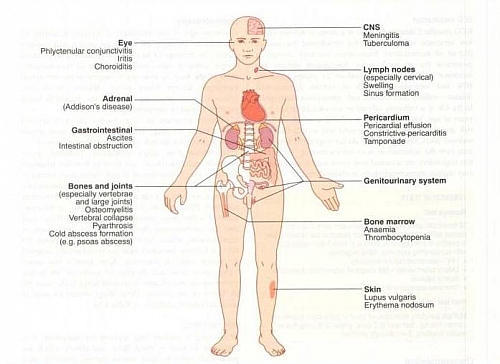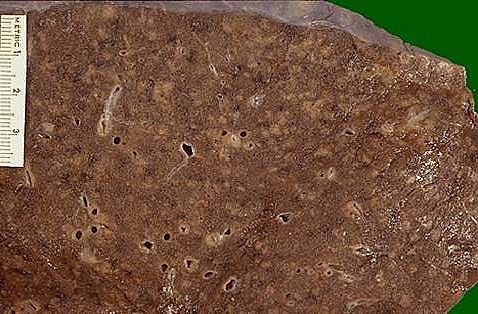Table of Contents
- What is Miliary Tuberculosis?
- Commonest sites of Miliary Tuberculosis
- Miliary Tuberculosis Causes
- Miliary Tuberculosis Symptoms and Signs
- Miliary Tuberculosis Radiology and Diagnosis
- Miliary Tuberculosis Laboratory Investigations and Results
- Miliary Tuberculosis Treatment
- Miliary Tuberculosis Differential Diagnosis
What is Miliary Tuberculosis?
Miliary tuberculosis is a form of Disseminated TB or Extrapulmonary TB that is caused by sudden diffuse dissemination of tubercle bacilli through the bloodstream (hematogenous spread of TB). Miliary Tuberculosis mainly occurs in children and young adults but may also occur in older people and it is insidious in onset in this older age group. Miliary TB is can be difficult to diagnose especially in older age group in which case it is known as Cryptic Tuberculosis (because of its insidious onset). Miliary Tuberculosis is fatal when left without treatment and death may occur within days or weeks.
Commonest sites of Miliary Tuberculosis
- Liver
- Spleen
- Kidney
- Adrenals
- Fallopian Tubes
- Epididymis
- Meninges
- Bones and Joints
Miliary Tuberculosis Causes
Miliary Tuberculosis is caused a primary tuberculosis infection arising from the lungs and spreading to the other parts of the body (dissemination) or it may be caused by reactivation of a latent focus of infection that was not active but has now become active due to immunosuppression for any reason such as long term use of drugs like steroids or chemotherapy (use of cytotoxic drugs) or comorbidities such as type 1 or type 2 diabetes mellitus.
Miliary Tuberculosis Symptoms and Signs
- Gradual onset of vague ill-health
- Loss of weight
- Fever
- Generalized lymphadenopathy (in about 40%)
- Pancreatitis
- Adrenal insufficiency
- Drenching night sweats
- Tachycardia (increased heart rate)
- Progressive anemia
- There may be cough and breathlessness
- Miliary Tuberculosis may present as tuberculous meningitis
- Usually there are no abnormal physical signs in the early stages of miliary TB but the liver and spleen eventually become enlarged
- Presence of Choroidal tubercles in the eyes (these choroidal tubercles are about one-quarter of the diameter of the optic disc and are yellowish and slightly shiny and raised in nature, later becoming white in the center. They may occur singly or multiple in each eye.
Miliary Tuberculosis Radiology and Diagnosis
- Miliary TB is characterized by the presence of numerous small nodular lesions that resemble millet seeds on chest x-ray. These lesions are about 1 to 2 mm in size.
- Abdominal Ultrasound scan will show hepatomegaly, splenomegaly and para-aortic lymph nodes
Miliary Tuberculosis Laboratory Investigations and Results
- Chest X-ray may appear normal in early phase of miliary tuberculosis as the sizes of the tubercles are not visible until they become about 1 to 2 mm in diameter. These lesions can increase in size up to 5 to 10 mm
- CT scanning may reveal lung parenchymal abnormalities at an earlier stage but it is more expensive
- Mantoux test (Tuberculin Skin Test) is usually positive but may be negative in 3050% of people with very severe disease in which the immune system cannot mount an attack.
- Trans-bronchial biopsies are frequently positive even before any abnormality is visible on the chest X-ray. Bone marrow biopsy and Culture and also Liver Biopsy and culture may be necessary in patients having Pyrexia of Unknown Origin (PUO). A trial of antituberculous drugs can be used in individuals with a Fever of Unknown (FUO/PUO); If the fever is due to Tuberculosis, there will be relief of fever within 2 weeks of starting chemotherapy. This is the approach used in susceptible individuals whom a diagnosis cannot be confirmed by other means.
Miliary Tuberculosis Treatment
Miliary TB is treated using the same drug regimens as pulmonary TB but treatment is generally extended for joint and bone tuberculosis (6 to 9 months) and TB meningitis (9 to 12 months) with the duration of treatment determined individually based upon clinical response. Steroids are used when there is meningitis or adrenal insufficiency. The response to treatment is judged based on the clinical and radiologic findings.
Miliary Tuberculosis Differential Diagnosis
- Sarcoidosis
- Staphylococcal pneumonia
- Mycoplasma pneumonia
These diseases can mimic the chest X-ray appearance of miliary tuberculosis.



